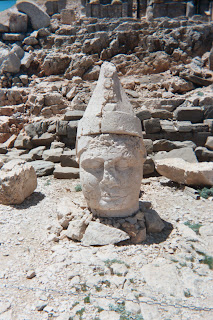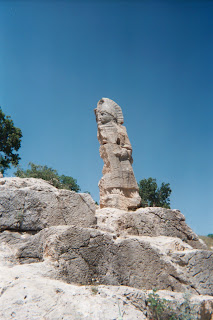
How exactly did the Roman army, in about 200 years conquer the then known Mediterranean world? Was it because they were better fighters than everyone else? Well, it seems clear that they were not usually as fierce as the Gauls, nor were they as good at cavalry and archery as the Parthians. What was it that gave them the edge?
Firstly, they were the best organized armies on the ground in general, and usually the best equipped. But secondly, and more importantly, they had the best engineers and engineering skills. When you actually traverse the ancient world and see the remarkable roads, bridges, aqueducts, siege ramps and the like built by Roman engineering, you have to be impressed. Above you will see an honorific column which stands on the big bridge depicted below. The big bridge depicted below is still used and usable after 2,000 years, which is more than I can say for the longevity of most similar constructions in America.
Who built all these remarkable roads and bridges? The soldiers themselves. This is why the honorific column above lists the legion involved during the time of Trajan and Nerva (i.e. late first early second century A.D.) who were proud of what they had accomplished. They knew that armies could not fight where they could not march, and so building incredible roads and bridges was a key to their conquering any country, but especially one as rugged and mountainous as Turkey.

What did they use for construction materials? They used good solid very local stones. Do not picture them hiking distances hauling huge rocks which then had to be hewn into building stones. The Romans were far too practical and sensible for that. The Romans were also far too practical and sensible to have an all volunteer army--you need a majority of trained professionals to do what they were doing, and they needed to have multiple skills. The Roman engineers' accomplishments make our army corp of engineers look ordinary most of the time. If the Roman corp of engineers were around, New Orleans would have been totally rebuilt a long time ago. Of course, they would have deliberately moved the whole city well back from the levies and the lake before they rebuilt the city, forcing the whole town to move further inland.

What you see just above here (enlarge the picture and look more closely) is a small bridge being traversed by a shepherd and sheep, right next to what is likely a watch tower. You can see another watch tower further along in the distance as well. This little bridge is crossing what is left of one of the tributaries the mighty Euphrates in eastern Turkey, after all the damming. The Romans didn't believe in building anything shabby. They built it to last, because they planned to rule forever (Roma aeterna). This is what comes from thinking and dreaming big and then acting on it with adequate skill.
There is a marvelous book on Roman bridges published by Cambridge U. Press (the oldest press in the English speaking world, with which I am proud to work). It is by Colin O' Connor, and it has many wonderful drawings of these bridges and roads which can be found everywhere from England all the way to eastern Syria and beyond, and from Spain all the way to Egypt and beyond. Unfortunately this book, entitled in good practical Roman fashion "Roman Bridges" is out of print and hard to come by. It lasted far less time than did the bridges described therein.
One of the things most impressive about Roman engineering is attention to detail and order. These folks were left brained to a fault. When you stand on top of Masada in Israel and look down at the still visible remains of the siege ramp and the siege camp of Flavius Silva you realize you are looking at engineering greatness. You can see it in these bridges as well-- they knew materials, angles, edges, inclinations, arches etc.
They didn't hire out to the lowest bidder! They didn't skimp on the right materials! They took the time to build things right. When they needed a road to go somewhere they did not take no for an answer. We could learn a lot from these folks. And above all they were almost always practical. They didn't build things for artistic effect-- they built it to be sturdy and last and take a lot of wear and tear. I could go on, but this is enough. They knew that attention to detail in regard to the small things was important. They could have invented the famous 'gradatio' saying---
'For want of a nail, the shoe was lost, for want of the shoe the horse was lost, for want of the horse the messenger was lost, for want of the messenger the battle was lost, for want of the battle the war was lost, and all for the want of a nail'. Think on these things.



























